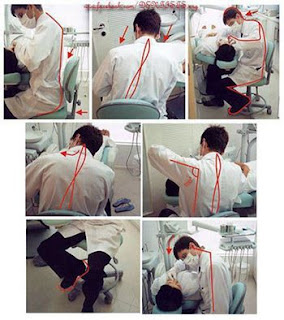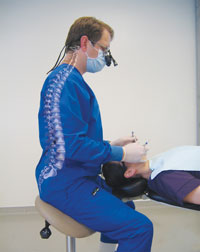I'm pretty sure that most of the dentists around the world have suffered from neck and back pain during their long years of practice and this is well documented in the literature. Obviously, this is due to the awkward spine positions during delivering the treatment to the clients/patients for a lengthy period. For that, they need to care more about their posture and practice the needed exercises to decrease the risk of musculoskeletal injuries.
- According to a systematic review, "the prevalence of general musculoskeletal conditions among dentists ranges between 63%-93%, back pain is considered to be the most prevalent condition (36%-60%) followed by neck pain (19.8%-85%)." (Hayes et al., 2009)
- In 19872 alone, dentists had to cancel 1.3 million patient appointments and lost income amounting up to $41 million — more than $65 million in nowadays measure.
- The following graph represents the prevalence of musculoskeletal conditions among dentists compared to a control group (non-dentists).
Awkward postures while working
Conditions that happens in the cervical spine
Upper crossed syndrome which consists of:-
- Forward head (anterior positioning of the cervical spine)
- Rounded shoulders (Kyphosis)
- For example, forward head posture increases the load on the facet joints of the cervical vertebra which causes pain.
Conditions that happen in the lumbar spine
-Back pain
"Dental professionals demonstrate a high prevalence of low back pain." (Gaowgzeh et al., 2015)
Reference
Reference
-Lumbar disc herniation (In advanced cases)
-Sciatica pain (mostly in severe cases & it's usually associated with lumbar disc herniation )
The person will feel:
-Sciatica pain (mostly in severe cases & it's usually associated with lumbar disc herniation )
The person will feel:
- Constant pain in the affected leg or buttock
- Pain increases with sitting or standing and decreases with walking
- Weakness in the affected side
- Numbness sensation down the leg
The prevalence of Carpal tunnel syndrome is 16.7% among dentists.
Carpal tunnel syndrome is basically a compression of the median nerve which causes weakness in the first 3 fingers and a half along with numbness and tingling sensations. Dentists use their hands more frequently while operating that's why they are at high risk of developing this condition after years of practice. It's more common in old dentists as it reaches 22.2% in ages more than 55 years old in contrast with 6% among dentist between the age of 25-34.
Sitting is weakening you!
Most of the dentists, especially dental students and interns complain about the long sitting hours while operating the patient. Static sitting for more than two hours might cause one or all of the following conditions:
1-Back pain: because the spine is not moving properly which causes stiffness in the muscle.
2-Varicouse veins (mostly in advanced cases): your blood doesn't flow as well if you're in the same position for a long time. Therefore, your veins will become varicose because the valves are not working properly. The prevalence of this condition increases if you're old, overweight or you have been practicing this habit for many years due to your work's nature.
I assume that after reading all these information you started to worry. However, I have the solutions prepared for you. The most important thing is the consistency of practicing the exercises and applying the ergonomincs.
You can perform them all at home, no need to go to a gym!
The following exercises can be used as prevention and treatment.
1-Neck exercises
A-Stretches
Start by stretching your muscles because they get tightened from your working position. Do each movement gently, breath normally, count till 30 in each movement, repeat them for five times, two sets.
B-Strengthening exercises
They should be performed against resistance. Start by applying the resistance with your hands then if you wish, you can upgrade by using a ball. Do them gently, breath normally, count till 10 in each movement, repeat them for five times, two sets.
2-Upper back exercises
These exercises will stretch and strength your upper back muscles so you don't develop a forward head and rounded shoulders posture.
A-Scapula movements
Strengthening for retraction and protraction movements of the scapula will keep your posture upright so you will be less suspectable to have a kyphotic posture.
 |
| Scapula movements You can perform the scapula protraction exercises from different positions. |
 |
| With resistance band Protraction with resistance band video |
 |
| With weights |
 |
| Without weights |
Scapula retraction
B-Trapezius muscles strengthening
Shoulder shrugs
3-Upper limb exercises
-Pectoralis minor stretch
This muscle gets tightened in rounded shoulder posture.
-General hand strengthening exercises
As I mentioned before, Carpal tunnel syndrome (CTS) occurs due to the repetitive use of hand movements, therefore you need to strength your hand muscles to prevent CTS.
The following tools help in strengthening hand muscles, they are available in sports shops and you don't need them all :)
-In case you feel pain in the wrist area and you DON'T have CTS or any other conditions, applying a cold pack for 10 minutes will help to relieve your pain.
-You may use a plastic bag full of ice cubes as a substitution for the cold pack.
3-Lower back exercises
A-Stretches
-Prayer position exercise is excellent for stretching your back muscles, you should feel the stretch along your whole spine and it should be pain-free. Do it for 30 secs, 5 times, 2 sets.
 |
| Prayer position |
-Back extension exercise
It can be performed from standing or supine position and it should be pain-free. Do it for 30 secs, 5 times, 2 sets.
-Gluteus Maximus muscle stretch
This muscle helps in stabilizing and protecting the spine while bending. If it's tight/weak, the load will increase on the spine while bending. Do it for 30 secs, 5 times, 2 sets.
Gluteus maximus strengthening (squats)
Instructions:
- Stand with your head facing forward and your chest held up and out.
- Place your feet shoulder-width apart or slightly wider. Extend your hands straight out in front of you to help keep your balance. You can also bend the elbows or clasp the fingers.
- Sit back and down like you're sitting into an imaginary chair. Keep your head facing forward as your upper body bends forward a bit. Rather than allowing your back to round, let your lower back arch slightly as you descend.
- Lower down so your thighs are as parallel to the floor as possible, with your knees over your ankles. Press your weight back into your heels.
- Keep your body tight, and push through your heels to bring yourself back to the starting position.
4-Core and abdominal muscles strengthening
The core muscles work as stabilizers for the back, so they need to be strong all the time to support your back and prevent back pain.
 |
| Core muscles |
-Multifidus strengthening exercise "aka" cat and camel exercise.
-Transverus abdominins strengthening exercise can be performed in different positions, but the one in the video is the most specific and effective one.
Your abdominal muscles need to be strong as well to stabilize your spine!
-Bridging exercise
- Starting position: Supine, arms on the side, knees bent, make sure your feet under your knees.
- Start by squeezing your buttock and abdominal muscles then raise your pelvis to create a straight line from your knees to your shoulders.
- Stay in this position for 20-30 seconds. Repeat 5 times, 2 sets.
4-Sciatica pain exercises
These are basically stretching exercises for the piriformis muscle that's affected in sciatica conditions. They are illustrated in the video. Do each exercise for 30-60 secs, 5 times, 2 sets
5-Thermotherapy for muscle spasm
Heat is very effective in relieving muscle spasm, as it improves the circulation and tissue metabolism.
-Hot packs
This one should be filled with hot water, wrapped by a towel and applied on the area which has spasm for 10 minutes only.
6-Tips to improve blood circulation in the lower limb
-Try to walk for few steps each 30 minutes- one hour.
-At home, Lay down with your legs elevated for 15 minutes; this will help in improving the blood flow in the veins. Do it 2-3 times in a week.
7-Ergonomics
Ergonomics prevent work-related musculoskeletal injuries if you apply them successfully. They also assure high productivity and worker's satisfaction.
Trunk bending shouldn't exceed 20 degrees.
Use saddle stools as they place the pelvis in a neutral position which allows the spinal curves to balance more easily in proper alignment.
I hope you benefit from the information I provided, and if you have any concern don't hesitate to contact me :)
E-mail:Ayaaalghouti@gmail.com
Instagram:@physioforlife











































